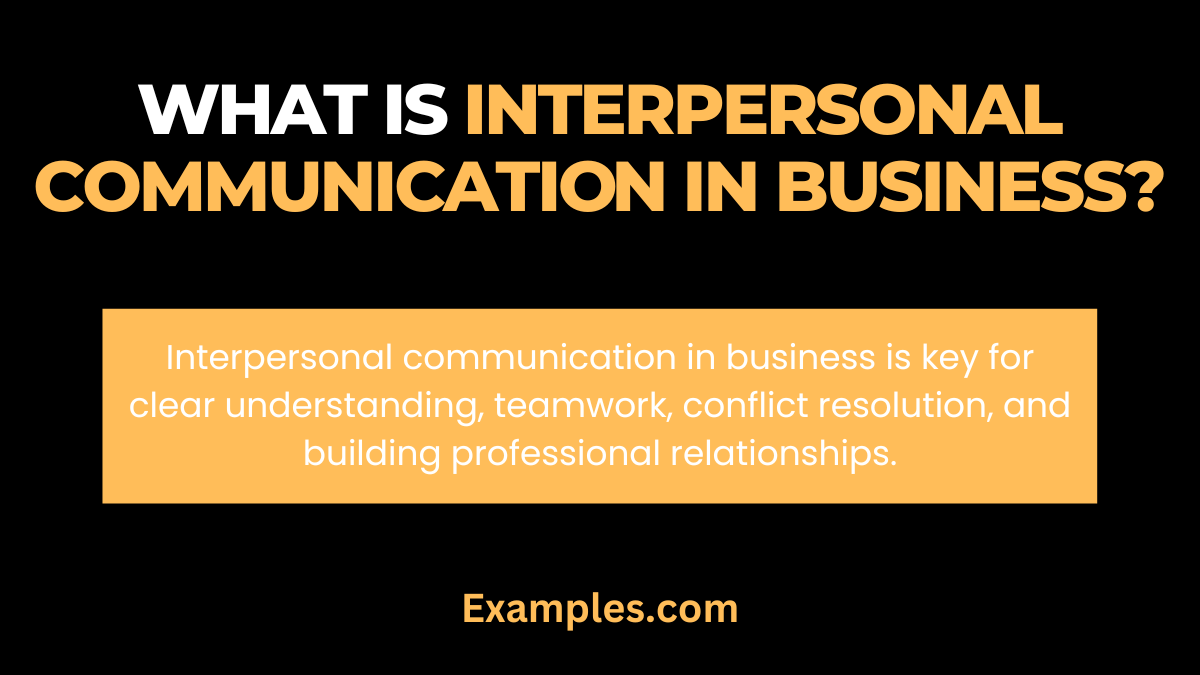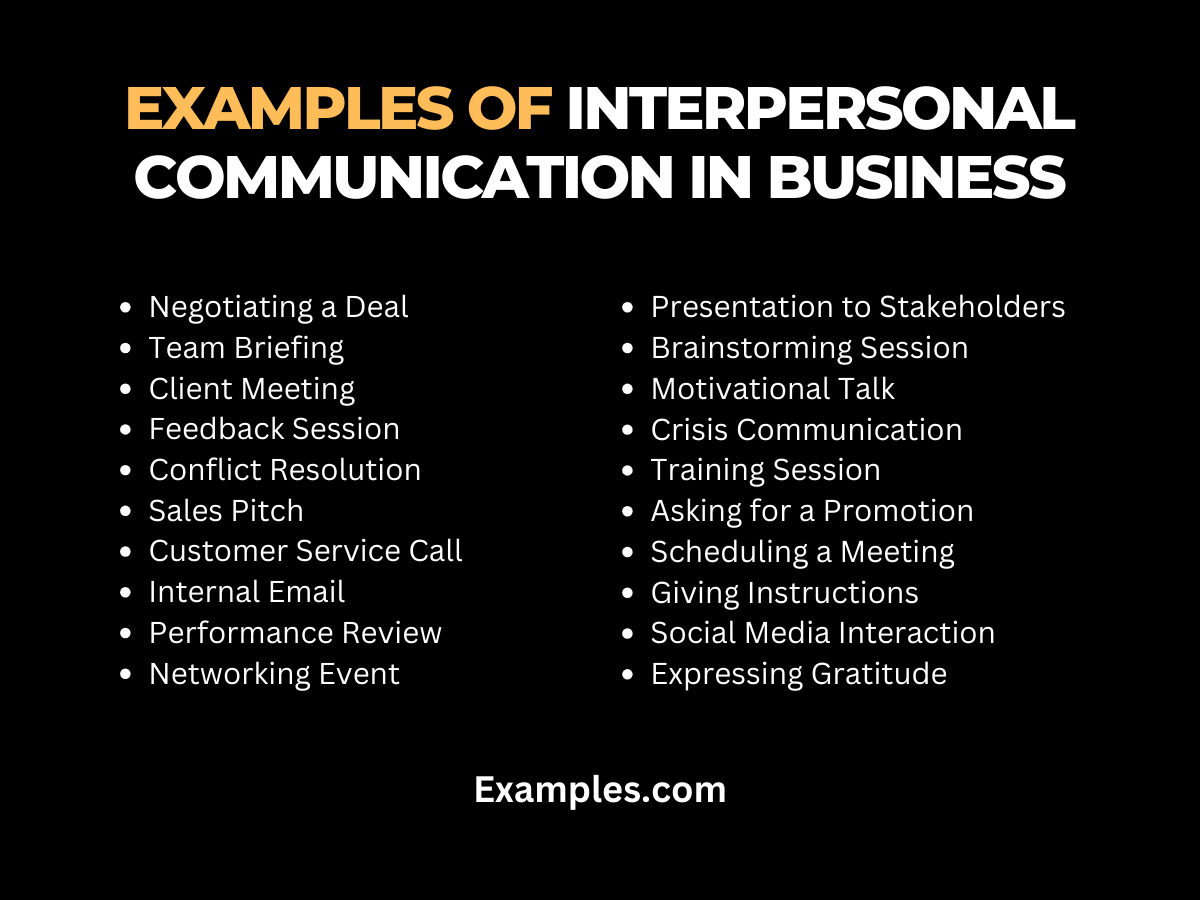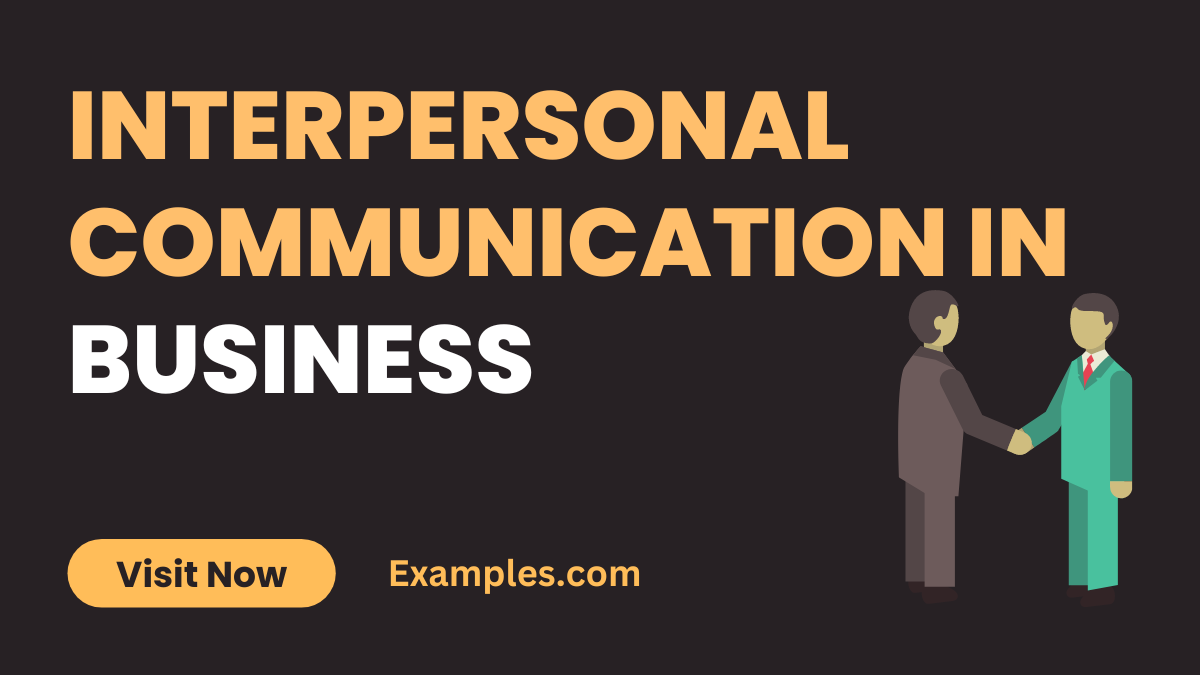19+ Interpersonal Communication in Business Examples
Interpersonal communication in business is a critical skill that involves effectively using oral communication and other forms to interact within a professional setting. It’s about conveying ideas, negotiating deals, resolving conflicts, and building relationships. Mastery of this skill enhances teamwork, facilitates clear understanding, and boosts overall productivity. From presentations to one-on-one conversations, effective interpersonal communication is key to professional success, enabling smoother operations and stronger professional networks.
What is Interpersonal Communication in Business?

Interpersonal communication in business refers to the process of exchanging information, ideas, and feelings between individuals within a professional context. This encompasses a range of communication methods, including verbal, non-verbal, and digital interactions. Effective interpersonal communication is essential for successful business operations, as it enables clear understanding, fosters teamwork, aids in conflict resolution, and builds strong professional relationships. In the business world, this form of communication is crucial for negotiation, leadership, team management, and customer relations.
20 Examples of Interpersonal Communication in Business

Interpersonal communication in business encompasses a range of interactions crucial for effective collaboration, negotiation, and relationship building. From formal meetings to casual check-ins, these communications shape the dynamics of business environments. Here are various examples illustrating how interpersonal communication manifests in different business scenarios, emphasizing its significance in achieving professional objectives and maintaining positive working relationships.
- Negotiating a Deal: “Let’s work towards a solution that benefits both our companies.” Negotiations require clear, persuasive communication to reach a mutually beneficial agreement.
- Team Briefing: “This project requires our collective efforts, so let’s align our goals.” Effective briefings involve clearly outlining objectives and roles.
- Client Meeting: “What are your main priorities for this project?” Understanding client needs through direct questioning.
- Feedback Session: “Your recent work has been impressive; let’s discuss how to tackle these new challenges.” Constructive feedback fosters growth and improvement.
- Conflict Resolution: “I understand both viewpoints; let’s find a middle ground.” Mediating disagreements with a focus on resolution.
- Sales Pitch: “Our product aligns perfectly with your current needs.” Crafting persuasive messages tailored to potential clients.
- Customer Service Call: “I’m here to help you resolve this issue.” Addressing customer concerns with patience and understanding.

- Internal Email: “Please find attached the report for your review.” Conveying information succinctly and professionally in written form.
- Performance Review: “Let’s discuss your progress and areas for development.” Balancing praise with constructive criticism.
- Networking Event: “I’ve been following your company’s growth, impressive work!” Initiating conversations that could lead to future collaborations.
- Presentation to Stakeholders: “Here’s our strategy for the next quarter.” Communicating complex information in an accessible manner.
- Brainstorming Session: “All ideas are welcome; let’s think outside the box.” Encouraging open and creative communication among team members.
- Motivational Talk: “Your hard work is driving our success.” Inspiring and motivating employees through positive reinforcement.
- Crisis Communication: “We’re taking immediate steps to address the issue.” Clear and calm communication during challenging situations.
- Training Session: “These skills will enhance your efficiency in this role.” Educating employees in a clear and engaging way.
- Asking for a Promotion: “I believe my contributions warrant further responsibilities.” Assertively communicating personal career aspirations.

- Scheduling a Meeting: “When is everyone available to discuss our next steps?” Coordination communication for organizational purposes.
- Giving Instructions: “Here’s how we’ll approach this task.” Clear directives to ensure understanding and compliance.
- Social Media Interaction: “We’re thrilled to hear your positive feedback!” Engaging with customers and the public online.
- Expressing Gratitude: “Thank you for your dedication to this project.” Acknowledging and appreciating team efforts
Types of Interpersonal Communication in Business
- Client Consultations: Direct interaction with clients to understand their needs and offer solutions.
- Employee Feedback Sessions: Regular feedback exchanges between supervisors and employees.
- Inter-Departmental Meetings: Collaboration across different departments for project coordination.
- Customer Support Dialogue: Direct customer interactions for service and problem resolution.
- Professional Networking: Building connections at industry events and meetings.
- Marketing Presentations: Presenting company products and services to potential clients.
- Training Sessions: Educational communication for employee development.
- Negotiation Discussions: Strategic negotiations with partners or stakeholders.
Barriers to Interpersonal Communication in Business
- Technological Hurdles: Difficulties in digital platforms affecting communication flow.
- Environmental Distractions: External noise and interruptions impacting conversation quality.
- Individual Perceptions: Personal views and prejudices leading to biased communication.
- Emotional Blocks: Personal feelings adversely affecting professional interactions.
- Complex Terminology: Overuse of technical jargon leading to confusion.
- Organizational Structure: Rigid hierarchy affecting open communication channels.
- Limited Interaction Time: Time pressure reducing the effectiveness of communication.
- Mental Distractions: Loss of focus due to external or internal stressors.
What are the Benefits of Interpersonal Communication in Business?
- Strengthening Team Cohesion: Encourages team unity and cooperative work.
- Building Customer Trust: Develops lasting client relationships and satisfaction.
- Smooth Conflict Management: Efficiently resolving workplace disputes.
- Boosting Workplace Efficiency: Streamlining operational processes for better output.
- Enhancing Employee Morale: Creating a supportive and inclusive work culture.
- Facilitating Better Decisions: Collective problem-solving for informed choices.
- Promoting Innovation: Sharing of diverse ideas and perspectives.
- Effective Risk Identification: Early detection and management of business challenges.
Importance of Interpersonal Communication in Business
- Expanding Professional Networks: Essential for creating and sustaining business relationships.
- Cultivating Leadership Qualities: Key for effective management and team leading.
- Positive Corporate Image: Maintaining the company’s reputation through external communications.
- Managing Organizational Change: Essential in guiding teams through company transitions.
- Understanding Market Needs: Essential for grasping customer preferences and market dynamics.
- Navigating Crisis Situations: Crucial during emergency communication and problem-solving.
- Engaging Key Stakeholders: Vital for keeping investors and partners informed and involved.
- Adapting to Global Markets: Critical for communicating across diverse cultural landscapes
Mastering interpersonal communication in relationships is essential for both personal growth and professional success. This guide has explored various aspects, from different types of communication to overcoming barriers and recognizing its benefits and importance. By applying these insights, individuals can enhance their communication skills, leading to stronger, more meaningful connections in both personal and professional spheres.



